System Thinking in Project Management: BP Horizon Oil Spill Analysis
VerifiedAdded on 2022/11/01
|9
|2563
|440
Report
AI Summary
This report analyzes the application of system thinking tools in project management, using the BP Deepwater Horizon oil spill as a case study. It examines how failures in leadership, communication, risk management, and organizational structure contributed to the disaster. The report explores various system thinking tools, such as concept maps, functional modeling, risk registers, and portfolio management software, that could have been employed to mitigate these failures. It highlights the importance of organizational maturity, proper portfolio alignment, and effective communication in preventing project breakdowns. The analysis underscores the significance of system thinking in fostering a holistic understanding of projects, enabling proactive risk management, and ultimately, improving project outcomes. The report emphasizes how these tools could have helped the project managers to prevent the blowout by improving management skills and commitment towards the project. The report also discusses the importance of organizational maturity and the role of communication in the success of the project.
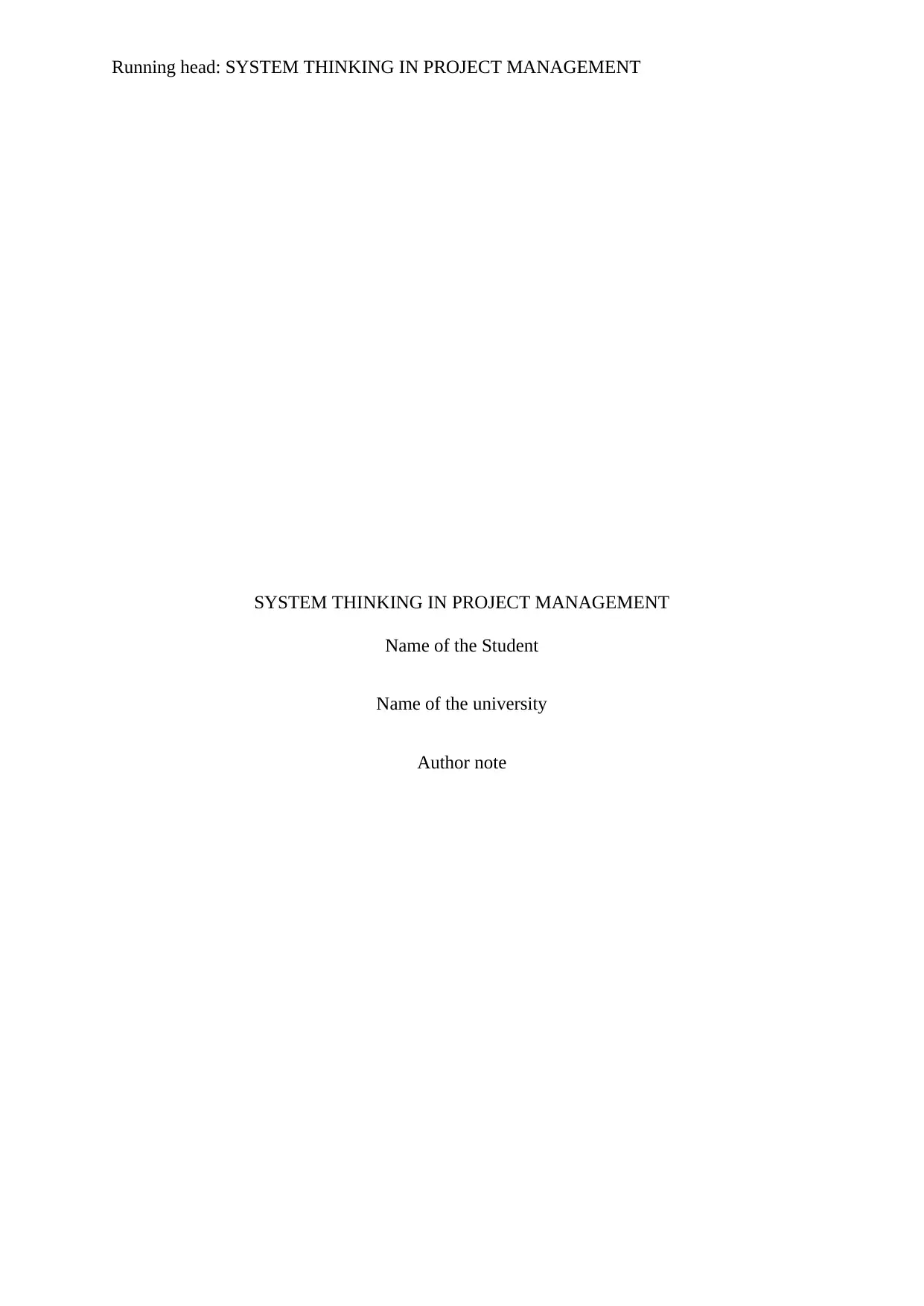
Running head: SYSTEM THINKING IN PROJECT MANAGEMENT
SYSTEM THINKING IN PROJECT MANAGEMENT
Name of the Student
Name of the university
Author note
SYSTEM THINKING IN PROJECT MANAGEMENT
Name of the Student
Name of the university
Author note
Paraphrase This Document
Need a fresh take? Get an instant paraphrase of this document with our AI Paraphraser
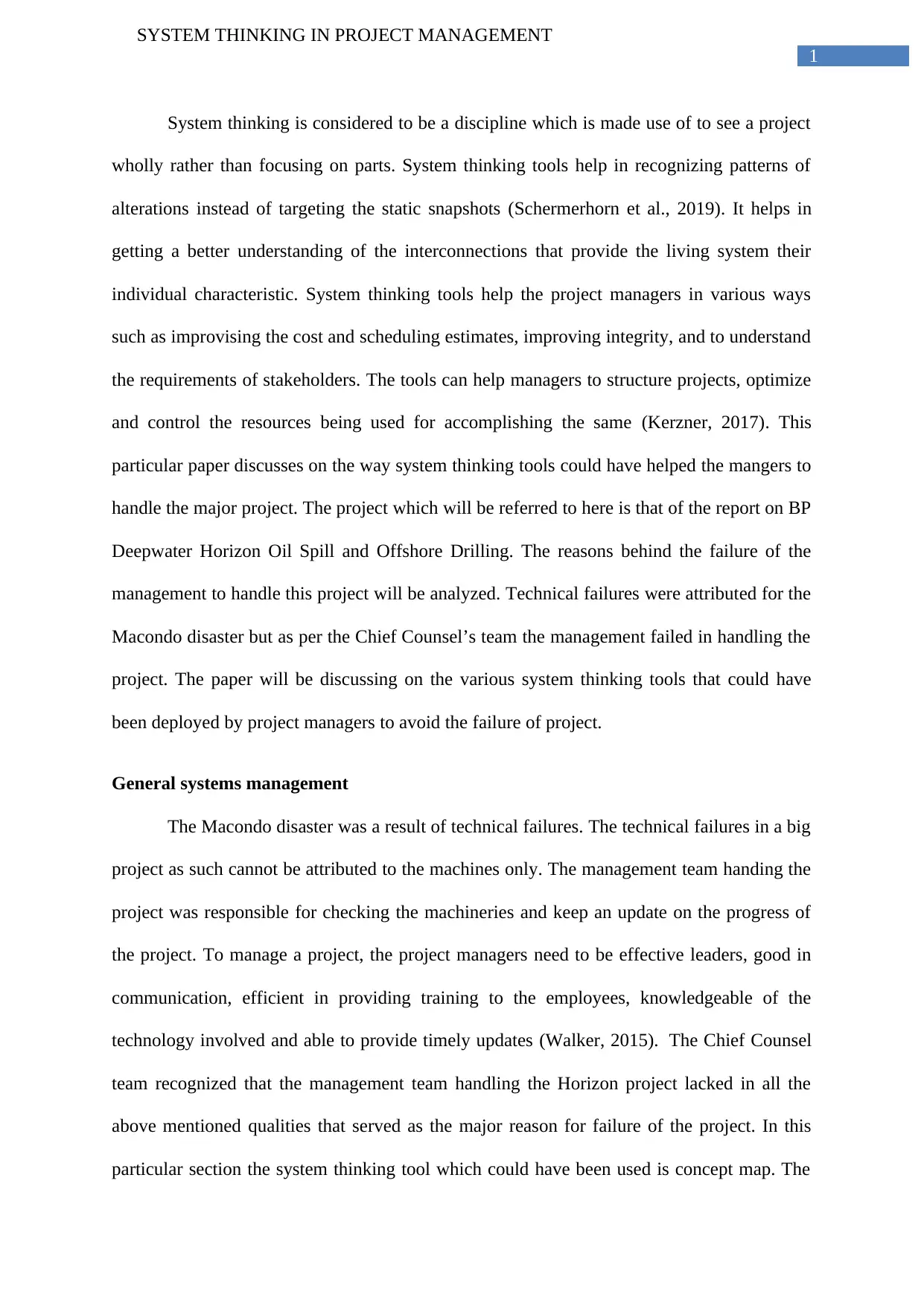
1
SYSTEM THINKING IN PROJECT MANAGEMENT
System thinking is considered to be a discipline which is made use of to see a project
wholly rather than focusing on parts. System thinking tools help in recognizing patterns of
alterations instead of targeting the static snapshots (Schermerhorn et al., 2019). It helps in
getting a better understanding of the interconnections that provide the living system their
individual characteristic. System thinking tools help the project managers in various ways
such as improvising the cost and scheduling estimates, improving integrity, and to understand
the requirements of stakeholders. The tools can help managers to structure projects, optimize
and control the resources being used for accomplishing the same (Kerzner, 2017). This
particular paper discusses on the way system thinking tools could have helped the mangers to
handle the major project. The project which will be referred to here is that of the report on BP
Deepwater Horizon Oil Spill and Offshore Drilling. The reasons behind the failure of the
management to handle this project will be analyzed. Technical failures were attributed for the
Macondo disaster but as per the Chief Counsel’s team the management failed in handling the
project. The paper will be discussing on the various system thinking tools that could have
been deployed by project managers to avoid the failure of project.
General systems management
The Macondo disaster was a result of technical failures. The technical failures in a big
project as such cannot be attributed to the machines only. The management team handing the
project was responsible for checking the machineries and keep an update on the progress of
the project. To manage a project, the project managers need to be effective leaders, good in
communication, efficient in providing training to the employees, knowledgeable of the
technology involved and able to provide timely updates (Walker, 2015). The Chief Counsel
team recognized that the management team handling the Horizon project lacked in all the
above mentioned qualities that served as the major reason for failure of the project. In this
particular section the system thinking tool which could have been used is concept map. The
SYSTEM THINKING IN PROJECT MANAGEMENT
System thinking is considered to be a discipline which is made use of to see a project
wholly rather than focusing on parts. System thinking tools help in recognizing patterns of
alterations instead of targeting the static snapshots (Schermerhorn et al., 2019). It helps in
getting a better understanding of the interconnections that provide the living system their
individual characteristic. System thinking tools help the project managers in various ways
such as improvising the cost and scheduling estimates, improving integrity, and to understand
the requirements of stakeholders. The tools can help managers to structure projects, optimize
and control the resources being used for accomplishing the same (Kerzner, 2017). This
particular paper discusses on the way system thinking tools could have helped the mangers to
handle the major project. The project which will be referred to here is that of the report on BP
Deepwater Horizon Oil Spill and Offshore Drilling. The reasons behind the failure of the
management to handle this project will be analyzed. Technical failures were attributed for the
Macondo disaster but as per the Chief Counsel’s team the management failed in handling the
project. The paper will be discussing on the various system thinking tools that could have
been deployed by project managers to avoid the failure of project.
General systems management
The Macondo disaster was a result of technical failures. The technical failures in a big
project as such cannot be attributed to the machines only. The management team handing the
project was responsible for checking the machineries and keep an update on the progress of
the project. To manage a project, the project managers need to be effective leaders, good in
communication, efficient in providing training to the employees, knowledgeable of the
technology involved and able to provide timely updates (Walker, 2015). The Chief Counsel
team recognized that the management team handling the Horizon project lacked in all the
above mentioned qualities that served as the major reason for failure of the project. In this
particular section the system thinking tool which could have been used is concept map. The
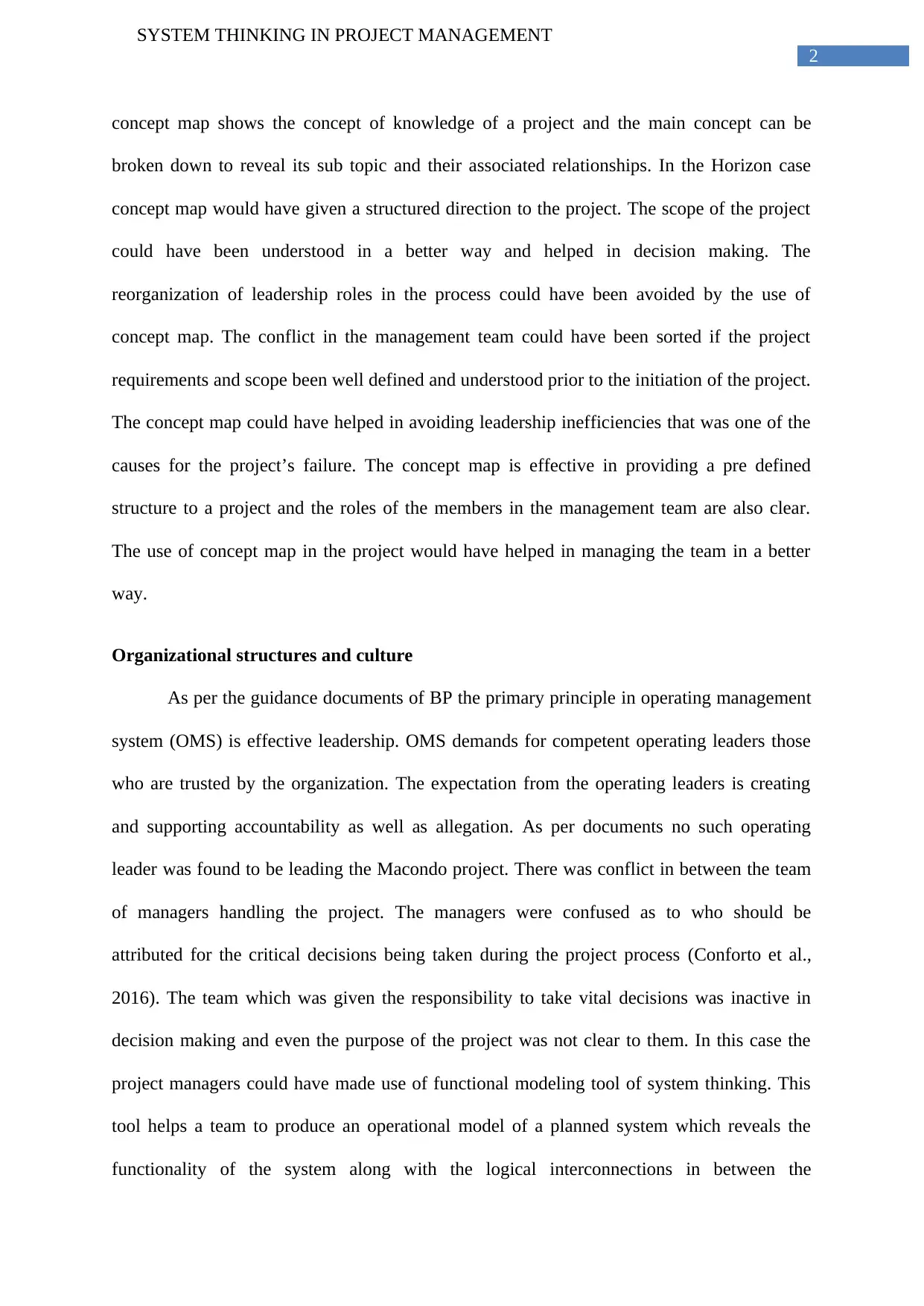
2
SYSTEM THINKING IN PROJECT MANAGEMENT
concept map shows the concept of knowledge of a project and the main concept can be
broken down to reveal its sub topic and their associated relationships. In the Horizon case
concept map would have given a structured direction to the project. The scope of the project
could have been understood in a better way and helped in decision making. The
reorganization of leadership roles in the process could have been avoided by the use of
concept map. The conflict in the management team could have been sorted if the project
requirements and scope been well defined and understood prior to the initiation of the project.
The concept map could have helped in avoiding leadership inefficiencies that was one of the
causes for the project’s failure. The concept map is effective in providing a pre defined
structure to a project and the roles of the members in the management team are also clear.
The use of concept map in the project would have helped in managing the team in a better
way.
Organizational structures and culture
As per the guidance documents of BP the primary principle in operating management
system (OMS) is effective leadership. OMS demands for competent operating leaders those
who are trusted by the organization. The expectation from the operating leaders is creating
and supporting accountability as well as allegation. As per documents no such operating
leader was found to be leading the Macondo project. There was conflict in between the team
of managers handling the project. The managers were confused as to who should be
attributed for the critical decisions being taken during the project process (Conforto et al.,
2016). The team which was given the responsibility to take vital decisions was inactive in
decision making and even the purpose of the project was not clear to them. In this case the
project managers could have made use of functional modeling tool of system thinking. This
tool helps a team to produce an operational model of a planned system which reveals the
functionality of the system along with the logical interconnections in between the
SYSTEM THINKING IN PROJECT MANAGEMENT
concept map shows the concept of knowledge of a project and the main concept can be
broken down to reveal its sub topic and their associated relationships. In the Horizon case
concept map would have given a structured direction to the project. The scope of the project
could have been understood in a better way and helped in decision making. The
reorganization of leadership roles in the process could have been avoided by the use of
concept map. The conflict in the management team could have been sorted if the project
requirements and scope been well defined and understood prior to the initiation of the project.
The concept map could have helped in avoiding leadership inefficiencies that was one of the
causes for the project’s failure. The concept map is effective in providing a pre defined
structure to a project and the roles of the members in the management team are also clear.
The use of concept map in the project would have helped in managing the team in a better
way.
Organizational structures and culture
As per the guidance documents of BP the primary principle in operating management
system (OMS) is effective leadership. OMS demands for competent operating leaders those
who are trusted by the organization. The expectation from the operating leaders is creating
and supporting accountability as well as allegation. As per documents no such operating
leader was found to be leading the Macondo project. There was conflict in between the team
of managers handling the project. The managers were confused as to who should be
attributed for the critical decisions being taken during the project process (Conforto et al.,
2016). The team which was given the responsibility to take vital decisions was inactive in
decision making and even the purpose of the project was not clear to them. In this case the
project managers could have made use of functional modeling tool of system thinking. This
tool helps a team to produce an operational model of a planned system which reveals the
functionality of the system along with the logical interconnections in between the
⊘ This is a preview!⊘
Do you want full access?
Subscribe today to unlock all pages.

Trusted by 1+ million students worldwide
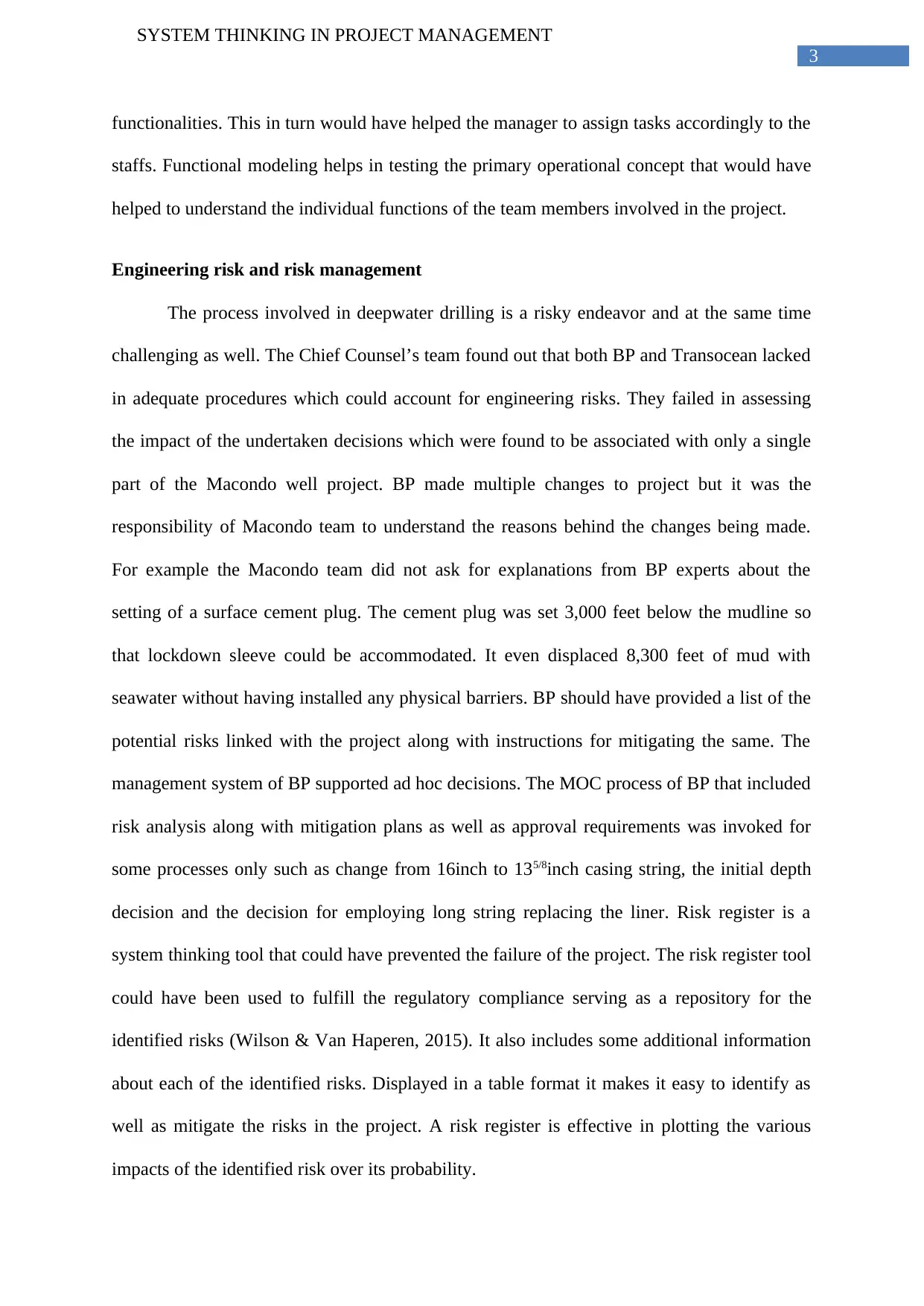
3
SYSTEM THINKING IN PROJECT MANAGEMENT
functionalities. This in turn would have helped the manager to assign tasks accordingly to the
staffs. Functional modeling helps in testing the primary operational concept that would have
helped to understand the individual functions of the team members involved in the project.
Engineering risk and risk management
The process involved in deepwater drilling is a risky endeavor and at the same time
challenging as well. The Chief Counsel’s team found out that both BP and Transocean lacked
in adequate procedures which could account for engineering risks. They failed in assessing
the impact of the undertaken decisions which were found to be associated with only a single
part of the Macondo well project. BP made multiple changes to project but it was the
responsibility of Macondo team to understand the reasons behind the changes being made.
For example the Macondo team did not ask for explanations from BP experts about the
setting of a surface cement plug. The cement plug was set 3,000 feet below the mudline so
that lockdown sleeve could be accommodated. It even displaced 8,300 feet of mud with
seawater without having installed any physical barriers. BP should have provided a list of the
potential risks linked with the project along with instructions for mitigating the same. The
management system of BP supported ad hoc decisions. The MOC process of BP that included
risk analysis along with mitigation plans as well as approval requirements was invoked for
some processes only such as change from 16inch to 135/8inch casing string, the initial depth
decision and the decision for employing long string replacing the liner. Risk register is a
system thinking tool that could have prevented the failure of the project. The risk register tool
could have been used to fulfill the regulatory compliance serving as a repository for the
identified risks (Wilson & Van Haperen, 2015). It also includes some additional information
about each of the identified risks. Displayed in a table format it makes it easy to identify as
well as mitigate the risks in the project. A risk register is effective in plotting the various
impacts of the identified risk over its probability.
SYSTEM THINKING IN PROJECT MANAGEMENT
functionalities. This in turn would have helped the manager to assign tasks accordingly to the
staffs. Functional modeling helps in testing the primary operational concept that would have
helped to understand the individual functions of the team members involved in the project.
Engineering risk and risk management
The process involved in deepwater drilling is a risky endeavor and at the same time
challenging as well. The Chief Counsel’s team found out that both BP and Transocean lacked
in adequate procedures which could account for engineering risks. They failed in assessing
the impact of the undertaken decisions which were found to be associated with only a single
part of the Macondo well project. BP made multiple changes to project but it was the
responsibility of Macondo team to understand the reasons behind the changes being made.
For example the Macondo team did not ask for explanations from BP experts about the
setting of a surface cement plug. The cement plug was set 3,000 feet below the mudline so
that lockdown sleeve could be accommodated. It even displaced 8,300 feet of mud with
seawater without having installed any physical barriers. BP should have provided a list of the
potential risks linked with the project along with instructions for mitigating the same. The
management system of BP supported ad hoc decisions. The MOC process of BP that included
risk analysis along with mitigation plans as well as approval requirements was invoked for
some processes only such as change from 16inch to 135/8inch casing string, the initial depth
decision and the decision for employing long string replacing the liner. Risk register is a
system thinking tool that could have prevented the failure of the project. The risk register tool
could have been used to fulfill the regulatory compliance serving as a repository for the
identified risks (Wilson & Van Haperen, 2015). It also includes some additional information
about each of the identified risks. Displayed in a table format it makes it easy to identify as
well as mitigate the risks in the project. A risk register is effective in plotting the various
impacts of the identified risk over its probability.
Paraphrase This Document
Need a fresh take? Get an instant paraphrase of this document with our AI Paraphraser
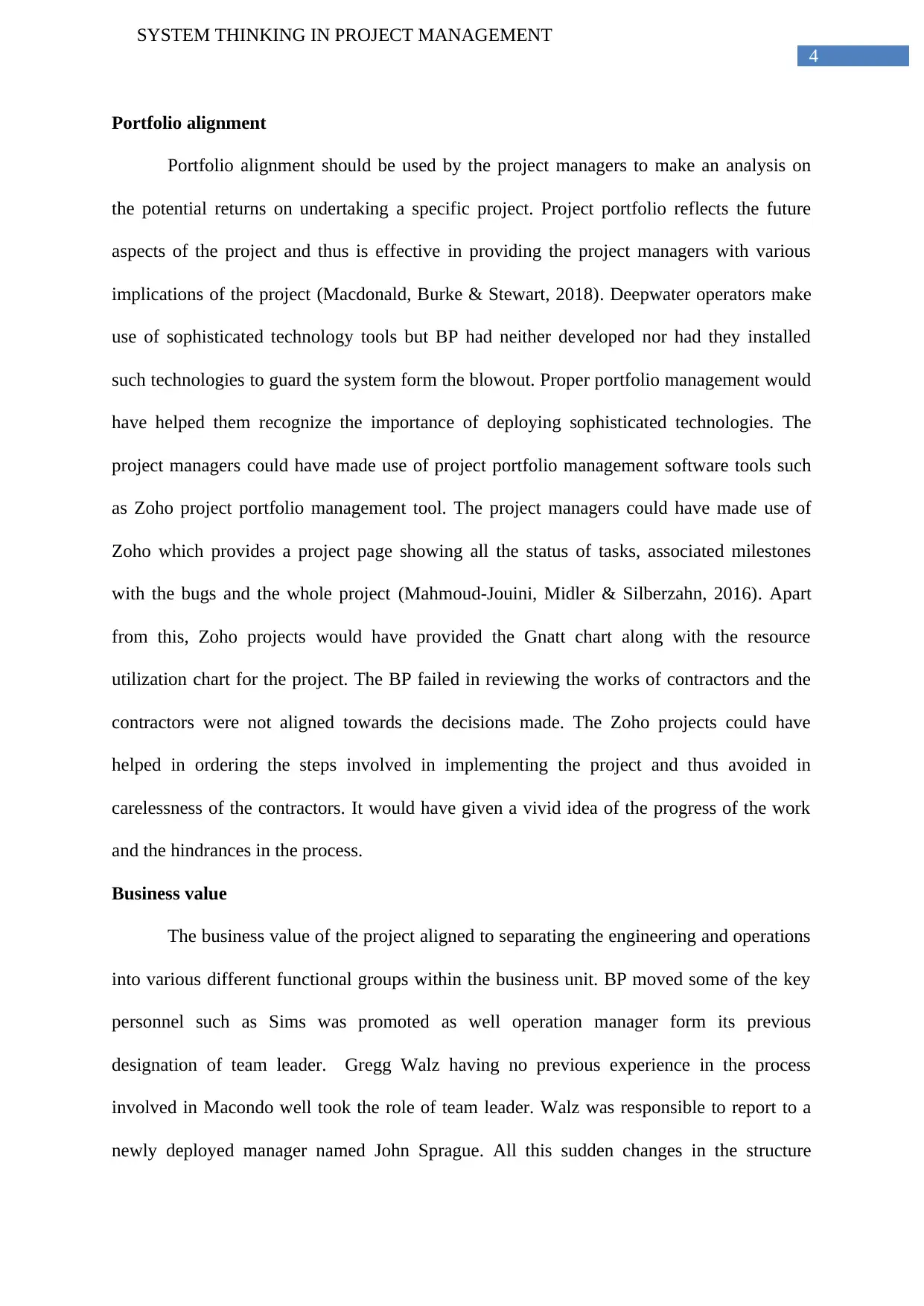
4
SYSTEM THINKING IN PROJECT MANAGEMENT
Portfolio alignment
Portfolio alignment should be used by the project managers to make an analysis on
the potential returns on undertaking a specific project. Project portfolio reflects the future
aspects of the project and thus is effective in providing the project managers with various
implications of the project (Macdonald, Burke & Stewart, 2018). Deepwater operators make
use of sophisticated technology tools but BP had neither developed nor had they installed
such technologies to guard the system form the blowout. Proper portfolio management would
have helped them recognize the importance of deploying sophisticated technologies. The
project managers could have made use of project portfolio management software tools such
as Zoho project portfolio management tool. The project managers could have made use of
Zoho which provides a project page showing all the status of tasks, associated milestones
with the bugs and the whole project (Mahmoud-Jouini, Midler & Silberzahn, 2016). Apart
from this, Zoho projects would have provided the Gnatt chart along with the resource
utilization chart for the project. The BP failed in reviewing the works of contractors and the
contractors were not aligned towards the decisions made. The Zoho projects could have
helped in ordering the steps involved in implementing the project and thus avoided in
carelessness of the contractors. It would have given a vivid idea of the progress of the work
and the hindrances in the process.
Business value
The business value of the project aligned to separating the engineering and operations
into various different functional groups within the business unit. BP moved some of the key
personnel such as Sims was promoted as well operation manager form its previous
designation of team leader. Gregg Walz having no previous experience in the process
involved in Macondo well took the role of team leader. Walz was responsible to report to a
newly deployed manager named John Sprague. All this sudden changes in the structure
SYSTEM THINKING IN PROJECT MANAGEMENT
Portfolio alignment
Portfolio alignment should be used by the project managers to make an analysis on
the potential returns on undertaking a specific project. Project portfolio reflects the future
aspects of the project and thus is effective in providing the project managers with various
implications of the project (Macdonald, Burke & Stewart, 2018). Deepwater operators make
use of sophisticated technology tools but BP had neither developed nor had they installed
such technologies to guard the system form the blowout. Proper portfolio management would
have helped them recognize the importance of deploying sophisticated technologies. The
project managers could have made use of project portfolio management software tools such
as Zoho project portfolio management tool. The project managers could have made use of
Zoho which provides a project page showing all the status of tasks, associated milestones
with the bugs and the whole project (Mahmoud-Jouini, Midler & Silberzahn, 2016). Apart
from this, Zoho projects would have provided the Gnatt chart along with the resource
utilization chart for the project. The BP failed in reviewing the works of contractors and the
contractors were not aligned towards the decisions made. The Zoho projects could have
helped in ordering the steps involved in implementing the project and thus avoided in
carelessness of the contractors. It would have given a vivid idea of the progress of the work
and the hindrances in the process.
Business value
The business value of the project aligned to separating the engineering and operations
into various different functional groups within the business unit. BP moved some of the key
personnel such as Sims was promoted as well operation manager form its previous
designation of team leader. Gregg Walz having no previous experience in the process
involved in Macondo well took the role of team leader. Walz was responsible to report to a
newly deployed manager named John Sprague. All this sudden changes in the structure
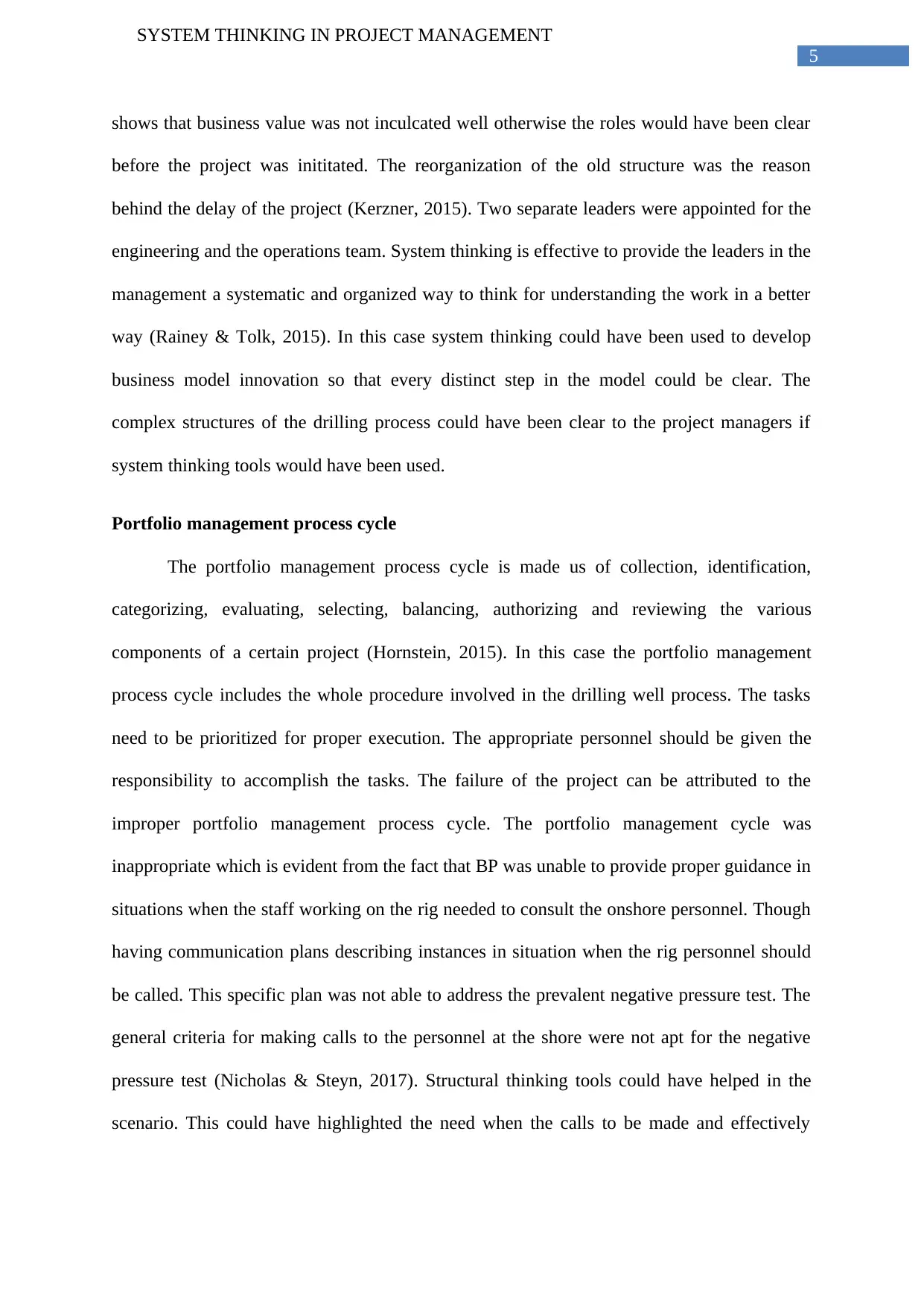
5
SYSTEM THINKING IN PROJECT MANAGEMENT
shows that business value was not inculcated well otherwise the roles would have been clear
before the project was inititated. The reorganization of the old structure was the reason
behind the delay of the project (Kerzner, 2015). Two separate leaders were appointed for the
engineering and the operations team. System thinking is effective to provide the leaders in the
management a systematic and organized way to think for understanding the work in a better
way (Rainey & Tolk, 2015). In this case system thinking could have been used to develop
business model innovation so that every distinct step in the model could be clear. The
complex structures of the drilling process could have been clear to the project managers if
system thinking tools would have been used.
Portfolio management process cycle
The portfolio management process cycle is made us of collection, identification,
categorizing, evaluating, selecting, balancing, authorizing and reviewing the various
components of a certain project (Hornstein, 2015). In this case the portfolio management
process cycle includes the whole procedure involved in the drilling well process. The tasks
need to be prioritized for proper execution. The appropriate personnel should be given the
responsibility to accomplish the tasks. The failure of the project can be attributed to the
improper portfolio management process cycle. The portfolio management cycle was
inappropriate which is evident from the fact that BP was unable to provide proper guidance in
situations when the staff working on the rig needed to consult the onshore personnel. Though
having communication plans describing instances in situation when the rig personnel should
be called. This specific plan was not able to address the prevalent negative pressure test. The
general criteria for making calls to the personnel at the shore were not apt for the negative
pressure test (Nicholas & Steyn, 2017). Structural thinking tools could have helped in the
scenario. This could have highlighted the need when the calls to be made and effectively
SYSTEM THINKING IN PROJECT MANAGEMENT
shows that business value was not inculcated well otherwise the roles would have been clear
before the project was inititated. The reorganization of the old structure was the reason
behind the delay of the project (Kerzner, 2015). Two separate leaders were appointed for the
engineering and the operations team. System thinking is effective to provide the leaders in the
management a systematic and organized way to think for understanding the work in a better
way (Rainey & Tolk, 2015). In this case system thinking could have been used to develop
business model innovation so that every distinct step in the model could be clear. The
complex structures of the drilling process could have been clear to the project managers if
system thinking tools would have been used.
Portfolio management process cycle
The portfolio management process cycle is made us of collection, identification,
categorizing, evaluating, selecting, balancing, authorizing and reviewing the various
components of a certain project (Hornstein, 2015). In this case the portfolio management
process cycle includes the whole procedure involved in the drilling well process. The tasks
need to be prioritized for proper execution. The appropriate personnel should be given the
responsibility to accomplish the tasks. The failure of the project can be attributed to the
improper portfolio management process cycle. The portfolio management cycle was
inappropriate which is evident from the fact that BP was unable to provide proper guidance in
situations when the staff working on the rig needed to consult the onshore personnel. Though
having communication plans describing instances in situation when the rig personnel should
be called. This specific plan was not able to address the prevalent negative pressure test. The
general criteria for making calls to the personnel at the shore were not apt for the negative
pressure test (Nicholas & Steyn, 2017). Structural thinking tools could have helped in the
scenario. This could have highlighted the need when the calls to be made and effectively
⊘ This is a preview!⊘
Do you want full access?
Subscribe today to unlock all pages.

Trusted by 1+ million students worldwide
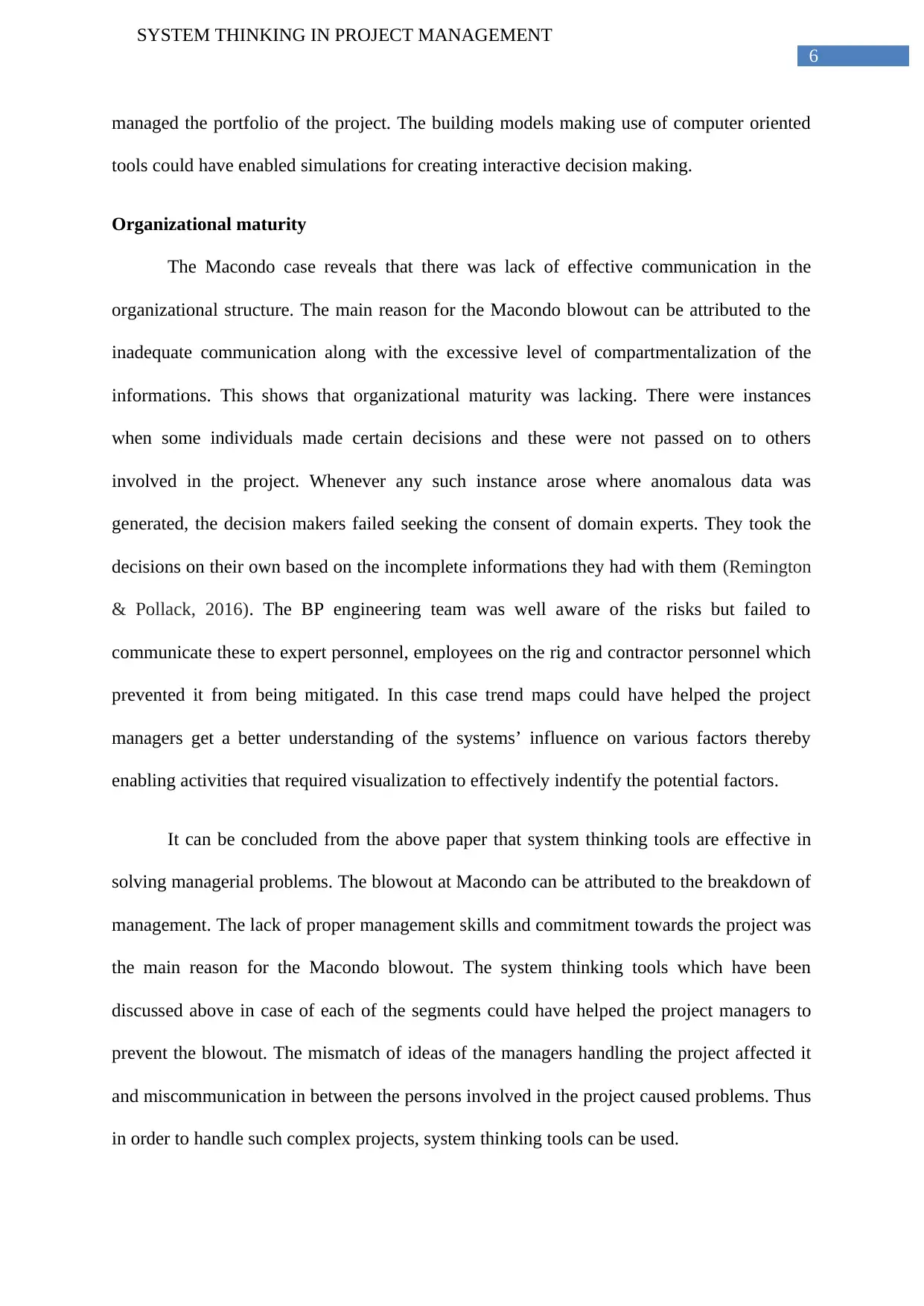
6
SYSTEM THINKING IN PROJECT MANAGEMENT
managed the portfolio of the project. The building models making use of computer oriented
tools could have enabled simulations for creating interactive decision making.
Organizational maturity
The Macondo case reveals that there was lack of effective communication in the
organizational structure. The main reason for the Macondo blowout can be attributed to the
inadequate communication along with the excessive level of compartmentalization of the
informations. This shows that organizational maturity was lacking. There were instances
when some individuals made certain decisions and these were not passed on to others
involved in the project. Whenever any such instance arose where anomalous data was
generated, the decision makers failed seeking the consent of domain experts. They took the
decisions on their own based on the incomplete informations they had with them (Remington
& Pollack, 2016). The BP engineering team was well aware of the risks but failed to
communicate these to expert personnel, employees on the rig and contractor personnel which
prevented it from being mitigated. In this case trend maps could have helped the project
managers get a better understanding of the systems’ influence on various factors thereby
enabling activities that required visualization to effectively indentify the potential factors.
It can be concluded from the above paper that system thinking tools are effective in
solving managerial problems. The blowout at Macondo can be attributed to the breakdown of
management. The lack of proper management skills and commitment towards the project was
the main reason for the Macondo blowout. The system thinking tools which have been
discussed above in case of each of the segments could have helped the project managers to
prevent the blowout. The mismatch of ideas of the managers handling the project affected it
and miscommunication in between the persons involved in the project caused problems. Thus
in order to handle such complex projects, system thinking tools can be used.
SYSTEM THINKING IN PROJECT MANAGEMENT
managed the portfolio of the project. The building models making use of computer oriented
tools could have enabled simulations for creating interactive decision making.
Organizational maturity
The Macondo case reveals that there was lack of effective communication in the
organizational structure. The main reason for the Macondo blowout can be attributed to the
inadequate communication along with the excessive level of compartmentalization of the
informations. This shows that organizational maturity was lacking. There were instances
when some individuals made certain decisions and these were not passed on to others
involved in the project. Whenever any such instance arose where anomalous data was
generated, the decision makers failed seeking the consent of domain experts. They took the
decisions on their own based on the incomplete informations they had with them (Remington
& Pollack, 2016). The BP engineering team was well aware of the risks but failed to
communicate these to expert personnel, employees on the rig and contractor personnel which
prevented it from being mitigated. In this case trend maps could have helped the project
managers get a better understanding of the systems’ influence on various factors thereby
enabling activities that required visualization to effectively indentify the potential factors.
It can be concluded from the above paper that system thinking tools are effective in
solving managerial problems. The blowout at Macondo can be attributed to the breakdown of
management. The lack of proper management skills and commitment towards the project was
the main reason for the Macondo blowout. The system thinking tools which have been
discussed above in case of each of the segments could have helped the project managers to
prevent the blowout. The mismatch of ideas of the managers handling the project affected it
and miscommunication in between the persons involved in the project caused problems. Thus
in order to handle such complex projects, system thinking tools can be used.
Paraphrase This Document
Need a fresh take? Get an instant paraphrase of this document with our AI Paraphraser
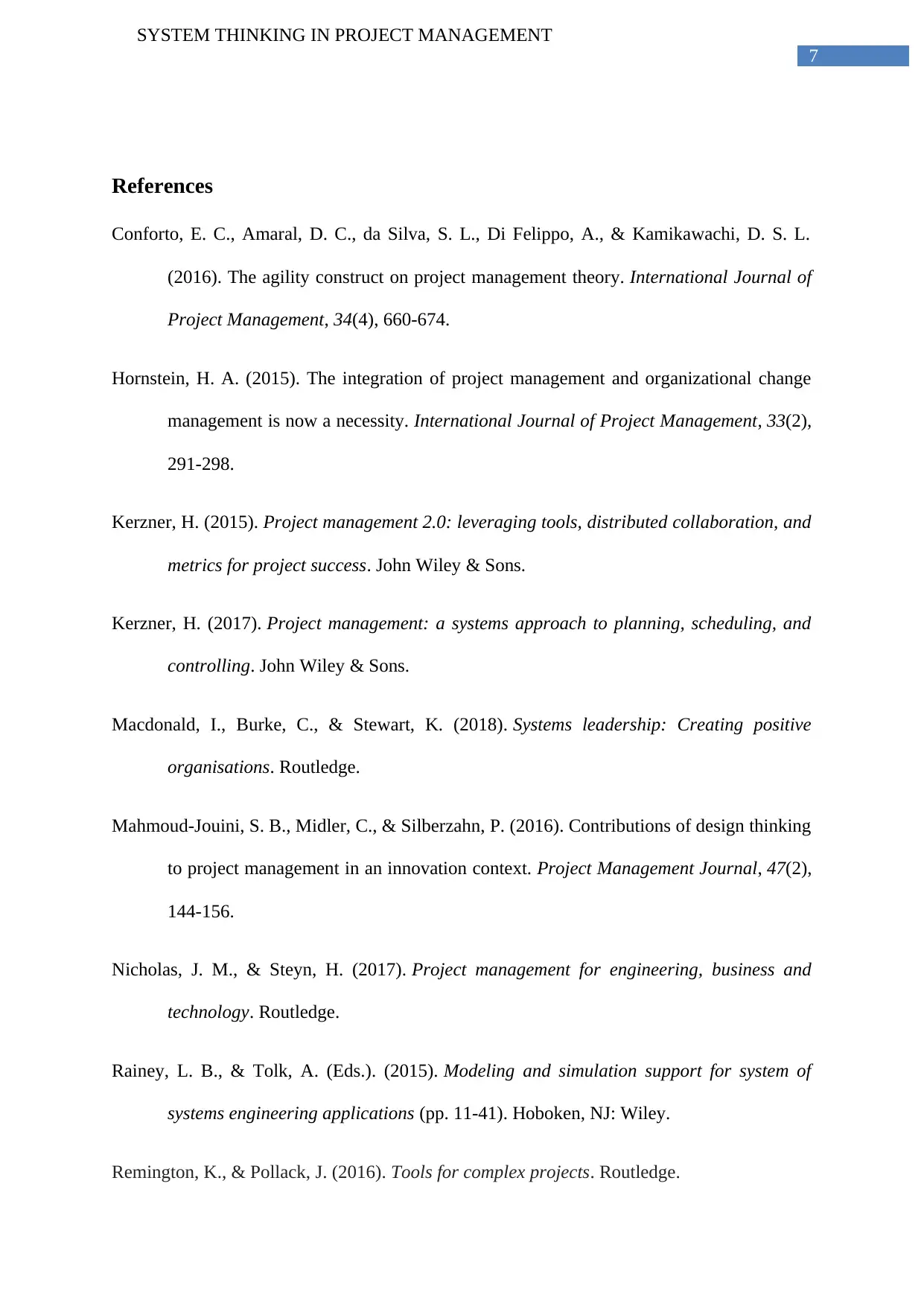
7
SYSTEM THINKING IN PROJECT MANAGEMENT
References
Conforto, E. C., Amaral, D. C., da Silva, S. L., Di Felippo, A., & Kamikawachi, D. S. L.
(2016). The agility construct on project management theory. International Journal of
Project Management, 34(4), 660-674.
Hornstein, H. A. (2015). The integration of project management and organizational change
management is now a necessity. International Journal of Project Management, 33(2),
291-298.
Kerzner, H. (2015). Project management 2.0: leveraging tools, distributed collaboration, and
metrics for project success. John Wiley & Sons.
Kerzner, H. (2017). Project management: a systems approach to planning, scheduling, and
controlling. John Wiley & Sons.
Macdonald, I., Burke, C., & Stewart, K. (2018). Systems leadership: Creating positive
organisations. Routledge.
Mahmoud-Jouini, S. B., Midler, C., & Silberzahn, P. (2016). Contributions of design thinking
to project management in an innovation context. Project Management Journal, 47(2),
144-156.
Nicholas, J. M., & Steyn, H. (2017). Project management for engineering, business and
technology. Routledge.
Rainey, L. B., & Tolk, A. (Eds.). (2015). Modeling and simulation support for system of
systems engineering applications (pp. 11-41). Hoboken, NJ: Wiley.
Remington, K., & Pollack, J. (2016). Tools for complex projects. Routledge.
SYSTEM THINKING IN PROJECT MANAGEMENT
References
Conforto, E. C., Amaral, D. C., da Silva, S. L., Di Felippo, A., & Kamikawachi, D. S. L.
(2016). The agility construct on project management theory. International Journal of
Project Management, 34(4), 660-674.
Hornstein, H. A. (2015). The integration of project management and organizational change
management is now a necessity. International Journal of Project Management, 33(2),
291-298.
Kerzner, H. (2015). Project management 2.0: leveraging tools, distributed collaboration, and
metrics for project success. John Wiley & Sons.
Kerzner, H. (2017). Project management: a systems approach to planning, scheduling, and
controlling. John Wiley & Sons.
Macdonald, I., Burke, C., & Stewart, K. (2018). Systems leadership: Creating positive
organisations. Routledge.
Mahmoud-Jouini, S. B., Midler, C., & Silberzahn, P. (2016). Contributions of design thinking
to project management in an innovation context. Project Management Journal, 47(2),
144-156.
Nicholas, J. M., & Steyn, H. (2017). Project management for engineering, business and
technology. Routledge.
Rainey, L. B., & Tolk, A. (Eds.). (2015). Modeling and simulation support for system of
systems engineering applications (pp. 11-41). Hoboken, NJ: Wiley.
Remington, K., & Pollack, J. (2016). Tools for complex projects. Routledge.
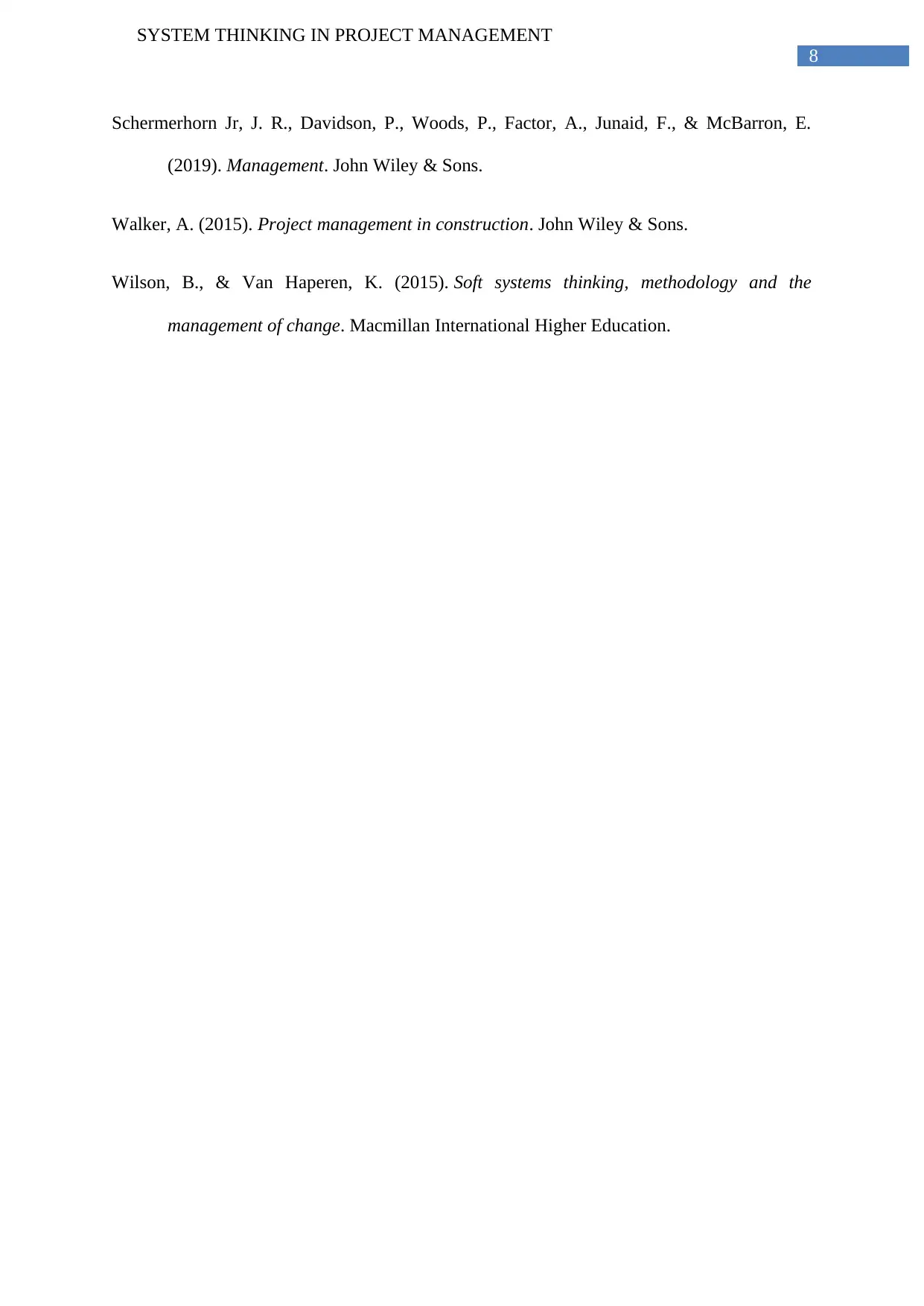
8
SYSTEM THINKING IN PROJECT MANAGEMENT
Schermerhorn Jr, J. R., Davidson, P., Woods, P., Factor, A., Junaid, F., & McBarron, E.
(2019). Management. John Wiley & Sons.
Walker, A. (2015). Project management in construction. John Wiley & Sons.
Wilson, B., & Van Haperen, K. (2015). Soft systems thinking, methodology and the
management of change. Macmillan International Higher Education.
SYSTEM THINKING IN PROJECT MANAGEMENT
Schermerhorn Jr, J. R., Davidson, P., Woods, P., Factor, A., Junaid, F., & McBarron, E.
(2019). Management. John Wiley & Sons.
Walker, A. (2015). Project management in construction. John Wiley & Sons.
Wilson, B., & Van Haperen, K. (2015). Soft systems thinking, methodology and the
management of change. Macmillan International Higher Education.
⊘ This is a preview!⊘
Do you want full access?
Subscribe today to unlock all pages.

Trusted by 1+ million students worldwide
1 out of 9
Related Documents
Your All-in-One AI-Powered Toolkit for Academic Success.
+13062052269
info@desklib.com
Available 24*7 on WhatsApp / Email
![[object Object]](/_next/static/media/star-bottom.7253800d.svg)
Unlock your academic potential
Copyright © 2020–2025 A2Z Services. All Rights Reserved. Developed and managed by ZUCOL.





